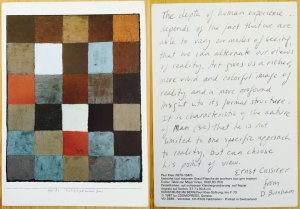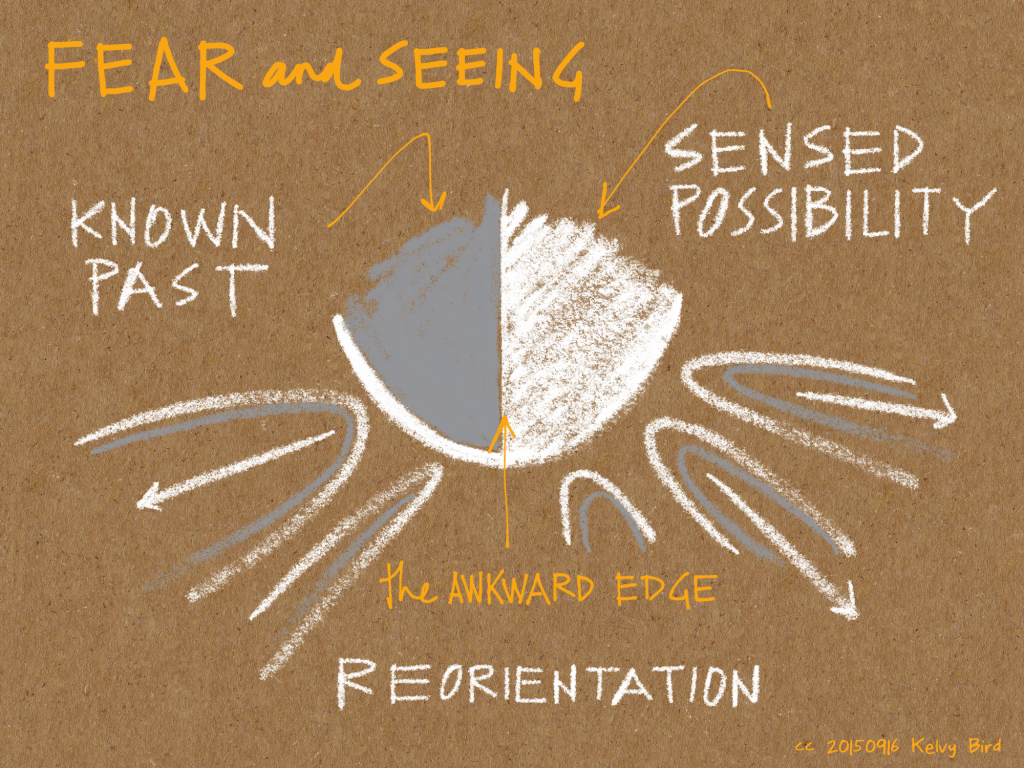Years ago, a friend sent me this quote from Ernst Cassirer: “The depth of human experience… depends on the fact that we are able to vary our modes of seeing, that we can alternate our views of reality. Art gives us a richer more vivid and colorful image of reality, and a more profound insight into its formal structure. It is characteristic of the nature of man (sic) that he is not limited to one specific approach to reality, but can choose his point of view.”
I had rewritten the quote on a postcard of Paul Klee’s Farbtafel (auf majorem Grau) / Colour Table (on Major Gray) 1930. That the post card seems colorful – a range of rust, slate gray, bark, wet New England earth, night sky, fog – is testament to Klee’s genius, where he could reference the primary color as gray, yet stretch the subtlety to its maximum proportion through his experiments representing perception.
The postcard tumbled out of John Berger’s book Ways of Seeing, sweeping me off my feet in 1987 during a college course: art in social context. “Seeing comes before words. The child looks and recognizes before it can speak…. It is seeing which establishes our place in the surrounding world…”
The book found me again the other morning while I was seeking to re-familiarize myself with Jungian archetypes, specifically an interpretation where Fear is a gateway to Magician energy. I was seeking solace, and insight, having gone to bed the night before in tears (truly), anticipating with great fear an upcoming session for U.Lab where I will probably scribe for the largest audience of my entire life. (Ug.) Rationally, I know I am ready, that everything will be okay, and that there are many people supporting the success of this class, the broadcasts, and my part in that. (Etc.)
The fear was palpable, though, and to dismiss it would negate a huge amount of energy that also resides in its quivering, distasteful shell. To relate to that fear, and not call it unfounded or irrational or irrelevant even, was necessary to engage it.
I also went to bed that night wondering, “Is there a ratio between fear and potential? Is the scope of fear proportional to the scope of possibility in my hands, in our hands?”
“When two colors meet they form and edge whose enormous aesthetic potential can be realized only if the edge is treated as the occasion for drawing… To one side we will have solidity, hence mass; to the other, air and light.” – “The Man Who Forgot How to Paint” by Richard Hennessey. Art in America, Summer 1984.
Perhaps fear is the awkward edge between the past, the known (solidity) and possibility, the sensed (air and light).
Feeling unnaturally connected to the broader population of (at that time) ~35,000 people participating in this u.lab[1] broadcast – where I actually knew only a few dozen people participating, many others as small pictures on website profiles, and still others as nameless but named interested parties – feeling this kind of connection brings with it a sense of great responsibility. Not being able to see this global body might have contributed to the anxiety, since my heart felt bound to this forming organism.
How can I honor the whole that is wanting to emerge when I cannot see it?
Perhaps to see it, it is necessary to orient with another point of view. To do this, it is necessary to embrace the fear. It is only by relating to the fear, and using it as fuel, that the hand will open, extend, draw.
I know, i “K”now, that the fear I am (was) feeling is an indicator of some change necessary in me – me simply as a microcosm of our forming Lab, where change is necessary at system and global levels. This is probably the reason such a large number of people gravitate to the course: we either know the change we want to be part of, or we sense internally that change is required.
Personally, I really do not want anything to change, to be honest. For the planet and species? Of course. But change is really hard for me to metabolize, though I have a vault of coping strategies, based on a life of frequent rotation. Naturally, it is terrifying to be part of such a global movement wanting to activate change.
I cannot lay dormant. I must get up. I must show up. (Replace I with WE.) But in order to do this, I must also embrace fear, and somehow receive it as a gift. And this is where seeing enters.
Through seeing, we experience. Through experience, we perceive. Through perception, we orient. Through orientation, we choose, and direct ourselves. With this direction, we act.
How to see? How to see expansively, with true clarity? A starting point might be to recognize our spheres of awareness and, launching with the energy of the awkward edge of fear, take one step outside our comfort zones. Turn around. Look in another direction. Notice. Repeat, Repeat. Turn. Again.
[1] u.lab: Transforming Business, Society, and Self is an online MOOC (Massive Online Open Courseware) offering through MIT’s edX platform, initiated in January 2015 in conjunction with the Presencing Institute’s u.school ecology, “a global action research platform, and an eco-system of online and offline communities, working to understand and transform the underlying causes of the ecological, social, and spiritual crises of our time.” https://uschool.presencing.com/

